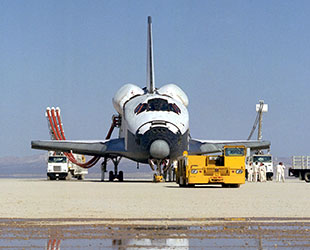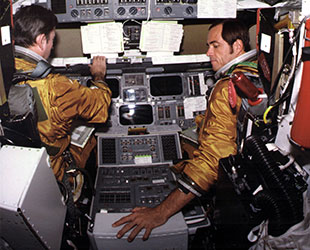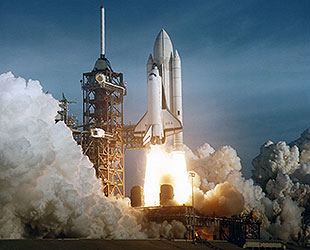April 10, 2006 — Twenty-five years ago this week, two men embarked upon an unprecedented mission. Aboard the world's first spacecraft designed to be reusable, the experienced commander and rookie pilot would set many firsts over the two day space flight, setting the stage for the next chapter in U.S. space activities after the Apollo lunar program had come to an end. First however, STS-1 needed to prove that the winged Space Shuttle Columbia could safely launch into space as a rocket and return as an engine-less glider.
collectSPACE.com recently spoke with STS-1 Commander John Young and Pilot Robert Crippen via the phone about the 25th anniversary of their mission, their memories of the flight and its legacy. Although their conversations were separate, the following combines both of their comments:
Your mission has been described as "the boldest test flight in history." What made it such?
John Young (JY): "I think if you look at all the things we had to do, flying a winged launch vehicle into space without any previous unmanned test, it probably was very bold and we thought we knew a lot more than we did."
Did you realize it was "the boldest" at the time?
Robert Crippen (RC): "Some of my test pilot friends might challenge it — because there have been lots of important test flights — however the Space Shuttle was a unique test flight and both John and I knew that.
"It was the first that we had ever flown on a vehicle that hadn't been launched unmanned before into space, so that was truly unique. And then we were flying with the first solid rockets that had ever been used for human space flight. We were flying on a winged vehicle that would do reentry different than we had ever done before and come back in and land on a runway. So all of those were firsts — and test pilots truly love firsts — so it was a big deal for both John and I."

The space shuttle Columbia on Rogers Dry lakebed at Edwards Air Force Base in California after landing to complete the first orbital mission, STS-1, on April 14, 1981. (NASA) |
Much has been made of STS-1 being manned, rather than flying without a crew. Was that a consideration?
JY: "They wanted to fly the thing unmanned. I went to many, many meetings where they [said they] wanted to fly the thing unmanned, but finally the program manager up at [NASA] Headquarters John Yardley, he said he wasn't going to come across California with nobody in the spacecraft. So, we got to fly it manned. It's probably the safe way to do it. We looked at California and there were all kinds of places you can land out there... including the freeways, which I saw in a TV movie where they did land on the freeway." (laughs)
That would have been a wild ride...
JY: "Oh, I'll tell you... especially when you went under a bridge. You'd probably have left the tail up there."
Bridging topics, how were you selected to fly STS-1?
JY: "I think it was pure luck. There was 20-some guys in the astronaut office and they would've all killed to be the first guys to fly. I guess I was picked by the guys in the leadership, like George Abbey and the people that ran the Johnson Space Center, like Chris Kraft.
"I guess they picked me because I was the only guy left with a lot of experience in space."
Crip, why were you chosen as pilot?
RC: "Beats the hell out of me. (laughs)
"I've never figured that out. Selection of crews is always been somewhat of a mystery but John was a natural. He was the chief of the astronaut office, had flown in space four previous times, so obviously he was the right guy to command the first flight.
"There were a lot of choices they could have made about who flew in the right seat, I'm glad of the choice that they made but I've never truly understood it. Truthfully, I think as evidenced by the subsequent crews, the intent of the powers that be at the time was to expand our knowledge base of people that had flown in space as rapidly as possible, so they were flying right hand seats with people that had not flown before and the left hand with people that had flown before. The astronaut office had shrunk down to about 25 people at that time prior to the hiring we had done in '78, so I think they just wanted to expand the knowledge base and I'm happy for whatever reason I got to be the first one."
John, did you have a hand in selecting Crip?
JY: "I don't remember. To tell you the truth, I don't think I did. I thought it was a good idea to fly with Crip because he had done the work on the software. He had over 600 people out in Downey, California working with him on [the] software. Of course, the Space Shuttle is all software- driven. Back in those days, fly-by-wire software-driven systems were kind of unusual and new in airplanes. So, it was good to have Crip along because we had 110 pages pages of software and 154 switches in the spacecraft were powered by the software. You could throw a switch and you were actually putting words through the computer to open or close valves and things like that."
Do you remember where you were when you learned you were chosen?
RC: "Yeah, I remember where I was. I believe it was the Enterprise we were bringing through Ellington on the back of a 747 for some fit test — I think it was headed for Kennedy Space Center — and I happened to be out there that day with George Abbey, who was director of the flight crew operations, which all of the astronaut office fell under him. And as George, in only his way could do, as we strolled around the vehicle looking up at it, he said words to the effect of 'Crip, how'd you like to do the first one?' Truthfully, I'm not sure I literally did it but I felt like turning handsprings out there on the taxiways and tarmac at Ellington. It was beyond my wildest dreams that I'd get to fly the first one. I had hoped I would get an early one but the first one was truly a unique experience. I'll remember George saying that to me for as long as I live."

STS-1 commander John Young and pilot Robert Crippen (right) log time in the space shuttle Columbia's crew cabin at Kennedy Space Center six month before their record April 1981 launch. (NASA) |
What was it like working with John Young?
RC: "John and I had an opportunity to train a lot more than what we probably envisioned initially since we did have some technical problems with the main engines and these things that were our thermal protection system we referred to as tiles that they glued onto the vehicle.
"So, John and I got to train for about three years before we went to fly and John is probably one of the funniest human beings. He has a very dry sense of wit but he is very funny. And I told people that I made a serious mistake in not taking a little log book and copying down John's one liners as we went through training because I could have sold that and John and I could have retired a lot sooner. (laughs)
"So if you are going to do something like that, that has the firsts that I spoke about previously, it's nice to go with an old pro, and John was our old pro and it was a pleasure flying with him."
What stands out in your memories of April 12 to April 14, 1981?
RC: "I like John's answer to that one: the part between take off and landing."
JY: "Well, it turned out to just be a great mission."
RC: "It was all fantastic. To get a chance to orbit into space in 8.5 minutes from sitting at zero to going 17,500 miles per hour and then getting to float around in zero-g and get to see this beautiful Earth of ours, going around it once every 90 minutes. And then flying reentry, not in a command module kind of a fashion, but in an airplane fashion."
How did the launch compare to the Saturn V?
JY: "It didn't shake near as bad but there were a little more Gs [forces of gravity] — 1.2 Gs on the Saturn V, 1.5 Gs at liftoff on the shuttle. We only got up to 3 Gs, well, and you only got up to a little over 2 on the Saturn V because we were putting so much payload in orbit."
Unlike today's Space Shuttle flights, you had a way out during launch.
JY: "You know, we had a range safety system on there, so they put ejection seats in so we could get out. Dr. [Robert] Gilruth told me this [shuttle] is going to be as reliable as a DC-8, you don't need the ejection seats. He told me this about three to four years before we flew, and when he said that, we were going out to look at the engine plants and they kept blowing up the engines. So, it didn't seem as though it was going to be as reliable as a DC-8. (laughs)
"Of course, if you had to use ejection seats to jump out while the solid rocket motors were still burning, you probably would have ignited yourself with the plumes of the solid rocket motors. So we sort of vowed we wouldn't do that if we didn't have to.
"To say [the shuttle] was operational after four flights, which is about what we did and took the ejection seats out, that was really reaching for it but that's what we did."
And reentry and landing?
JY: "I figured once we got through ascent, reentry would be a piece of cake and it turned out, it was."
RC: "I think I made some comment as we came over the coast, 'What a way to come to California!'. Setting up for a landing at Edwards [Air Force Base, having] flown out there hundreds of times, and John did a super job all the way to touchdown. So, it's something I will never forget."
JY: "I found out about 10 or so years ago, that we had buckled the right main landing gear door, one of the gap fillers had come out, and put hot gas into the wheel well, which could've been very bad because if the wheel well had gotten too hot in there, you've got those big tires in there and all three hydraulic systems, and that would've finished us off. So, we were lucky... and we didn't know it at the time.
"What you don't know won't hurt you, but sometimes it will I guess."

The April 12, 1981 launch at Kennedy Space Center's Pad 39A, just seconds past 7 a.m. ET, carries astronauts John Young and Robert Crippen on the Earth-orbital STS-1 mission. (NASA) |
What is the legacy of STS-1?
RC: "Well, I like to think of it as — again, as my buddy John Young put it when we got back down on the ground, not just talking about STS-1 — but we had the 'world's greatest all-electric flying machine'. It had, and still does have very unique capabilities in marrying flight crew with the payload: the amount of payload it can put on orbit; the fact that you can do construction while you are up there; [and] the fact that you got essentially a zero-g laboratory. It has done a lot in its history and STS-1 was just the opening curtain on that."
JY: "I think it's a great machine and a good test flight and it worked out infinitely better than I thought. I was really worried about ascent, it worked great, and then on-orbit was a piece of cake."
"I think it was an end-to-end test flight [that] couldn't have been any better. We tested everything out and proved everything would work and tested all the systems on the vehicle and the guys down at the Cape did a great job of putting it together the first time. It was a good test flight and that's what it was. It worked out real well. Captain Crippen really knows his software which is great. We had a lot of fun, too."
Twenty-five years later, is it time to retire the shuttle as NASA plans in 2010?
RC: "Well, all good things have to come to an end at some time. I would truly love to see us go back to the Moon and on to Mars; certainly the shuttle is not the right vehicle to make that happen. Something like the CEV [Crew Exploration Vehicle] is the right way to go.
2010, in my opinion, might be a little soon because I really do want to see us complete the [International] Space Station and I would like to see us do another revisit to [the] Hubble [Space Telescope]. Whether that will all fit in the time frame that they are worried about I am not sure, but I trust the people that are managing the program at this time and I have to defer to them to making the right decisions."
JY: "Well, I don't see how they can fly all the flights between now and 2010 with things like the weather down at the Cape. You know, we come into hurricane season for this July launch [of the next mission, STS-121] right now and golly, these guys are predicting we are going to have worse and worse hurricane seasons. I don't know, but I sure hope not. It's what they predict.
"So I think you can't retire the shuttle until you finish assembling the space station. My guess it will a be three or four years after that. Maybe we'll get lucky and be able to fly all these flights but I think it wouldn't be luck, because of the weather and all of the problems. They keep finding out new things; every time you turn around they are finding out something they didn't know about the good old Space Shuttle."
